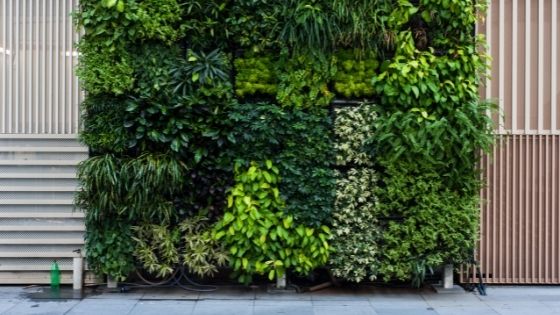Lush vertical gardens convert your home’s interior and exterior design without taking up precious ground space. However, these space-savvy green walls are not only beautiful. These boost your urban home’s association with nature, which enhances your health and well-being. When your home has a more substantial connection with nature, you can appreciate more profound relaxation, awe, vitality, joy, and enthusiasm.
Green walls deserve a place in your home and building designer often suggest that we have this at home. Here’s why you should install one in your place:
Give your home a biophilic touch
Humans have an intrinsic tendency to explore a connection with nature. As designers, we do our best to achieve this need in urban high-rise structures where our relationship with nature is often tenuous.
To do this, we use natural building stuff to construct homes. We load the house with living things such as indoor plants. Here’s where vertical plots come in. Grow multiple plant species in a green wall to heighten the biophilic impression. Growing plants result in measurable physical and physiological benefits to the occupants: reduced anxiety levels, heightened creativity, developed cognitive function, quicker healing, and a more profound spirit of happiness and well-being.
Need advice on putting in a green wall in your new home or renovation project? Ask a designer.
Improve indoor air quality
Most urban residents spend most of their days inside — in the office, in their homes, in confined and air-conditioned buildings and seldom go out for fresh air.
While this is convenient, this also exposes us to air with transparent, odorless toxins. We are smelling dangerous amounts of subtle organic compounds such as formaldehyde, trichloroethylene, carbon monoxide, benzene, toluene, and xylene. These pollutants can have hazardous health side effects.
Placing vertical gardens inside your home can improve getting rid of these toxic compounds. According to the well-known National Aeronautics and Space Administration (NASA), plants filter out these pollutants and purify the air inside the residence. Plants also help improve oxygen supply in the air, which makes you more productive at home.
Control noise
Hard exteriors in most residential buildings result in reverberation. Unwanted echoes and sound resonance from the other rooms can be distracting when you’re attempting to rest or entertain guests.
To address noise restriction, think of putting up a green wall strategically inside and outside the house. It will soften the noise because the leaves of plants absorb and reflect sound energy.
Make indoor rooms and outdoor spaces more relaxed and more convenient
Vertical gardens with lush greenery enhance indoor spaces by balancing the humidity levels, indoor cooling temperature, and airflow of your dream space. You are less likely to switch on the air conditioning to stay relaxed and comfortable in your home.
Green walls also create entertaining outdoor areas more relaxed during the summer. In conclusion, you and your guests will desire to spend more time out there. You end up using your outdoor space more.
Putting green walls inside and outside your house or even on a concrete floor is not only a win-win for you. It also helps reduce the city heat island outcome in urban areas.
The urban heat island effect is a result of land changes into cities. The mixed heat from the people, transportation, and the sun releases back into the surroundings and makes the town feel warmer than the rural regions nearby.
Plants consume thermal energy. We build more green areas to alleviate the urban heat island effect and make cities more sustainable with more vertical gardens.
Make your house healthier and more sustainable
The IMI is an advanced global organization that proposes transforming our buildings and cities to help people thrive. They have produced a new collection of guidelines called the WELL Building Standards, which allow designers to design more comfortable built environments that improve the health and wellness of the residents.
Based on the WELL Building Standards, green walls are one of the most desirable design innovations you can use to improve residential areas, incredibly tight spaces.
Where to put green walls in your home
In a usual studio apartment layout you can actually install green walls on courtyards and balconies with a way to natural light. Walls which take in the morning sunshine are perfect.
Choose local plant classes which can sustain in the area where you plan to install the green wall. Drought-tolerant plants can endure the harsh afternoon sun. Herbs and small plants are ideal for indoor use.
When lighting is inadequate, think about installing artificial lighting.
Consider planting succulents when you want a low-maintenance vertical garden. Ornamental and lush foliage needs more maintenance.
You can acquire easy-to-install green wall garden kits online. Make it a weekend DIY project. Ask advice from professionals or from any of your colleagues who have a green thumb.

















